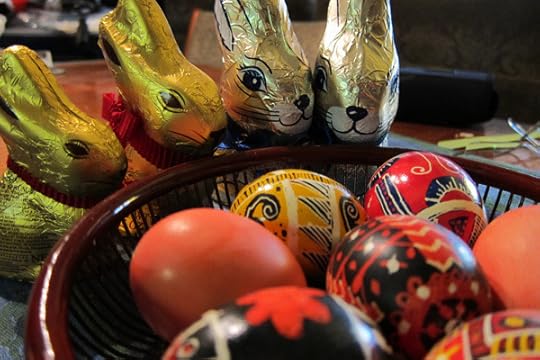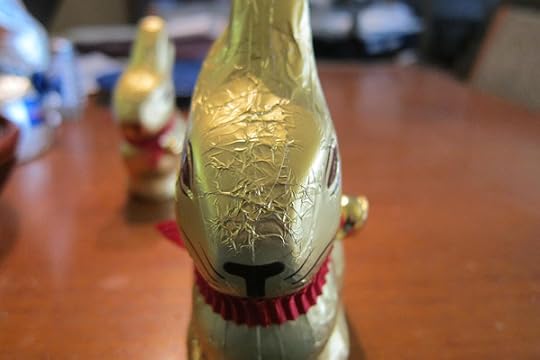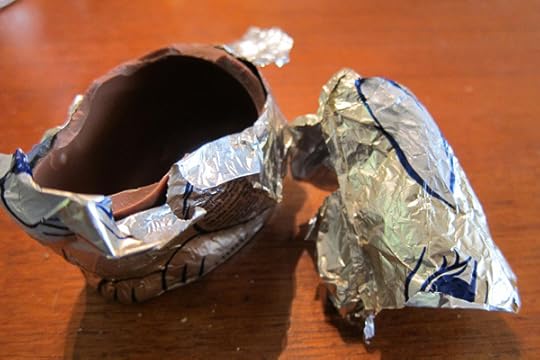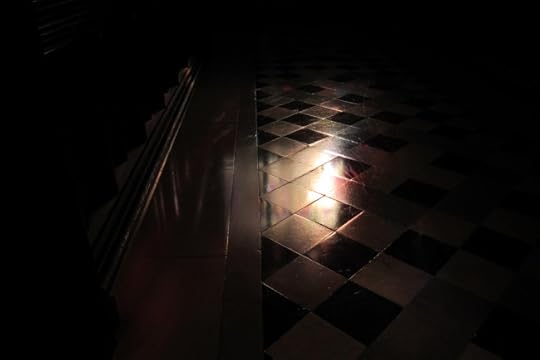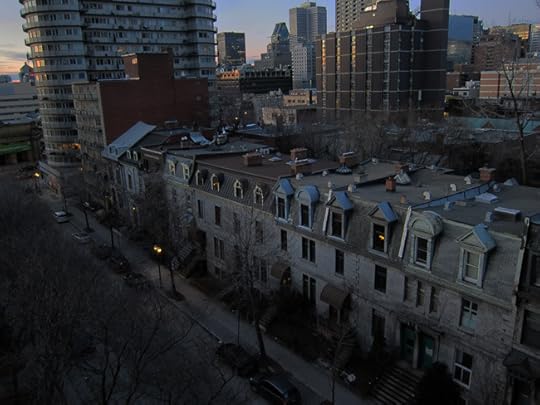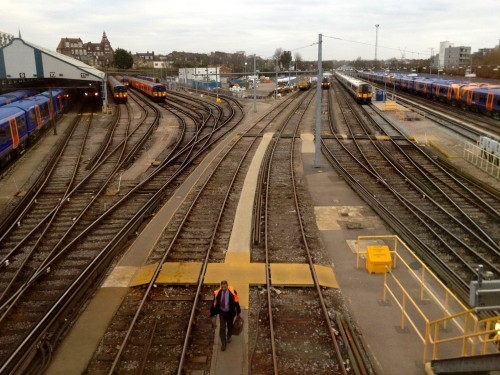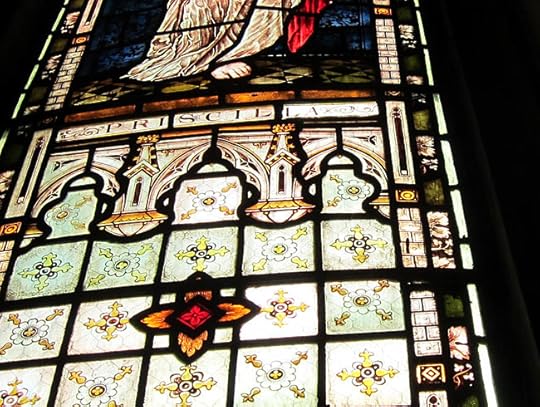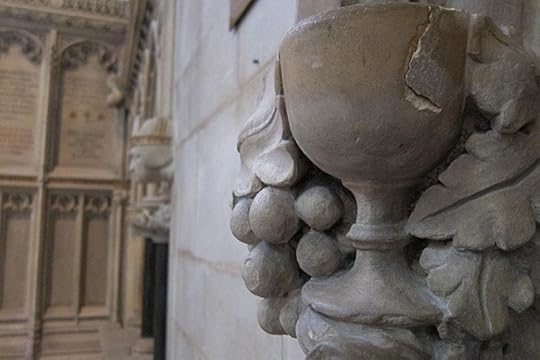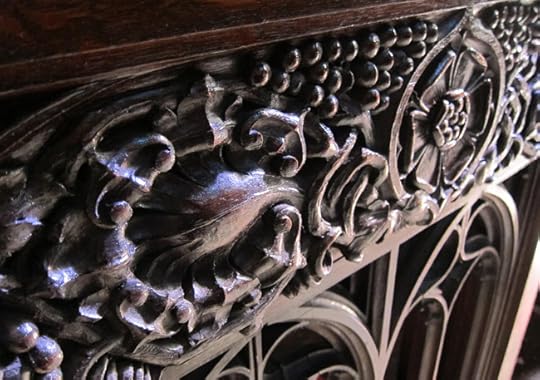Elizabeth Adams's Blog, page 100
April 11, 2012
A Bunny Tale (revised)
Unaware of their fate, the bunny family frolicked and played...
as bunnies do...
Then something -- what was it? -- seemed to spook them. They were seen huddling together.
Then their behavior became aggressive, even menacing.
And at night, one was caught trying to organize, sending communiques to other bunny cells and even to the chocolate eggs, which aren't considered mobile but can be highly dangerous.
That was too much for Management. All phones and tablets were confiscated. You can guess what happened in the morning.
The End (until next time.)
April 10, 2012
Unaware of their fate...
April 8, 2012
New
April 7, 2012
Into the Darkness
...waiting for dawn
rue Sainte-Famille, 6 am
We're up early, because we're moving home today. It's been a fascinating month, much of it lived high above the city, but I am so happy to be going home.
Today is a quiet day. I'm cleaning, doing laundry, making a big dish of scalloped potatoes for tomorrow evening's choir potluck, after we're all done, and catching up on a bit of blog reading and writing.
So here is some music (these are both pieces that we sang yesterday):
Jacob Handl, "Ecce, quomodo moritur iustus"
and here is the link to tomorrow's Easter Evensong by my own choir, to be broadcast on Sunday at 4:00 pm eastern daylight savings time, where you can hear us performing Ralph Vaughn Williams' "Five Mystical Songs" and a number of other works. It would be lovely to think of a few of you out there listening! (Go to the link and click the arrow where it says "Nous écouter en direct" (listen to us live.)
Visual art, not to be missed: RR's enigmatic and brilliant series of photographs entitled "Stations of the Week," at her blog Twisted Rib, of which she writes:
This series was inspired by a comment by Beth to an earlier post which was, not particularly wittily, entitled Stations of the cross London rail journey. She picked up on my (embarrassingly flippant) reference to the Christian tradition of the Stations of the Cross and asked "Why not do a whole set of contemporary London "stations of the cross" during Holy Week?"
This left me in something of a dilemma. I loved the idea but am not a Christian and know little of the iconography of the Stations of the Cross nor the ritual and significance of Holy Week. I felt uncomfortable about attempting anything relating to something I knew nothing about...
However it occurred to me... that they didn't have to be an equivalent of or reference to anything in particular, they could be dealt out in pairs over the seven days (14 stations over one week) just as they are, working together or not, working with the viewer or not, but as a possible prompt for reflection.
Station 12, by RR
And, finally, here's a wonderful post, with very moving photographs, about the ordination of a Buddhist nun in Korea two days ago; she is an American woman who I met online seven years ago. As I wrote to her just now, to me the message of both our paths seems the same: May we love one another, may our hearts be as one, may we all cease wrong-doing, may all beings one day be free.
April 6, 2012
Three Days
Churchyard, Lavenham, England, October 2011
Triduum: The Three Days: an explanation at the Wikipedia
Solus ad victimam, by Kenneth Leighton, sung by the Salisbury Cathedral Choir. We performed this piece at Evensong last week, on Palm Sunday.
Feet
Last night, Maundy Thursday, we celebrated the institution of the Eucharist, or Communion, by Jesus at the "Last Supper:" his Passover meal with the disciples. The Gospel of John, unlike the other accounts of that night, tell us that Jesus, knowing he was about to die and wanting to make symbolic, even startling gestures that the disciples would remember, took off his outer garment, wrapped a towel around himself, filled a basin with water, and began washing the disciples' feet. During the Maundy Thursday liturgy, the priests do this same thing: they remove their elaborate outer robes, and taking towels and basins of water, wash the feet of the parishioners who come forward. Fr. Richard Rohr explains the symbolism this way:
Perhaps John realized that after seventy years, the other Gospels had been read. He wanted to give a theology of the Eucharist that revealed the meaning behind the breaking of the bread. He made it into an active ritual of servanthood and solidarity, instead of the priestly cult that it has largely become.
After the service, some of the bread and wine is reserved for communion today, Good Friday, which sets it apart from every other day of the year. And then the lights are dimmed and the altar stripped. In our church, a small side chapel has been made into a "garden", to remind us of Gethsemanii, where Jesus prayed all night that he might be spared, knowing he would be betrayed by one of his followers. There are green plants, and many candles, and people keep a vigil all night long. Every time Jesus returned to his disciples, during that long night, he found them asleep and he sadly rebukedthem, saying, "Could you not stay awake with me one hour?" Later, when he had been arrested and taken away, they all deserted him and fled.
I always leave Maundy Thursday feeling disturbed, sorry, and wondering about our shared human weaknesses, and my own. What are the times in my life when I've deserted the people I love most? How have I betrayed my friends, my beliefs, my better self? How am I still doing that?
Good Friday, today, is somehow easier for me to take, easier to understand, even with its focus on grief and suffering, which remind us of our wn griefs. It recounts the trial, public execution, and death of an innocent person, something we have seen again and again in our world. Someone else did that, I can tell myself, as I always do when I read the papers or see the latest atrocity. I'm not directly responsible. It seems like I can always convince myself that there is a "they" who is more guilty than I am.
The Maundy Thursday questions, for me, are much harder; I cannot wriggle free.
April 5, 2012
Cup
You must be willing to drink this cup, we're told, more than once during this week of lamentation; we'll also hear the condemned man cry "Take this cup from me!" But what is my cup? What is the draught I'm asked to drink? Is it new wine, or bitter herbs?
Yesterday, my husband and I made a trip to a marble and stone seller in the northern part of the city to pick out two small pieces for our renovated bathrooms. When we stepped into the showroom, we nearly fell over. Polished rectangles of stone, from all over the world, hung on the walls and on two wall-to-ceiling panels, each piece more beautiful than the next. The colors ranged from white to green to rosy pink to black, with a dazzling array of patterns. We worried that we wouldn't be able to afford any of them, even the small pieces we needed, but saw two we completely loved. The Italian saleswoman introduced us to a man she said would help us. Go with him into the back room, she said, and he'll show you what's available.
We stepped through a door, out of the shiny showroom, and into a huge dusty warehouse filled with slabs of marble and stone in wooden racks. Step very carefully here, he cautioned, as we skirted a piece of bright yellow equipment. And here, watch your step, it's wet...the floor was slimy with stone dust and water. Still, we moved through the warehouse far more quickly than we wanted -- neither of us had ever seen anything like it -- and into a second huge room, this time a work bay with saws and other types of heavy equipment. Small slabs of stone were stacked against the back wall. Here, let's see if we have something that will suit you, he said.
We quickly found a piece of grey-veined carrera that was perfect for the shower sill, and he wrote our name on it with a grease pencil. The other we were looking for was red, we told him, and his face clouded. I don't think I have any small pieces of red marble, he said, leading us over to a very large one, big as a dining room table. We only needed a piece 3 inches by 66, we said, hopefully. How about another stone, he suggested. Granite? Please show us, we asked. He led us again to the back wall, and ran his finger across the first of two tall narrow pieces; his swipe revealed a deep red. We looked at each other. That would be perfect we said. It looked exactly like the sample we had loved in the showroom, which had apparently been granite, not marble. He measured the first: 64 inches, and shook his head. Maybe the one in the back, he said; it was taller, but had a notch at the top so that it was quite narrow. Let's see. He took out his tape again and stretched it; 68 inches. And you needed 3 inches across? Yes...he measured the top. 3 1/2 inches. He smiled and looked at me: perfect! he said. Meant to be! I answered. Yes, meant to be! It's yours. He wrote our name again, and we went out to find out the price from the saleswoman. She calculated, subtracted the contractor's discount: it was a very reasonable figure, and we nodded, that was fine.
From there, my husband dropped me at a metro station; I had one hour before I needed to be at the cathedral to teach two meditation sessions in the afternoon. When I arrived at the McGill station, downtown, I stepped out of the train and started up the steps. Over on the other side of the same stairs, where people were descending, sat a man on the very bottom step. He was slumped to one side, his long white hair unkempt, and in one hand he held a white baseball hat. As I hurried up the stairs I noticed, even at a distance, that something seemed wrong with his eyes. I climbed to the top, and then stopped, turned around, and watched. The commuters streamed by him, not noticing, or perhaps refusing to notice. Then someone stopped and seemed to bend down; no, he was just getting a better grip on the bicycle he was carrying up from the train. The man slumped further against the wall; there was a puddle near his feet that was probably urine. That was the point of decision; I turned around and headed back down the stairs, feeling in my backpack for my purse and in my pockets for any loose change.
The trains had gone; no one else was on the stairs. The man's head was bowed and he didn't look up even when I approached and stood near him. I bent down, and put all my change into the baseball hat which tipped to one side: open, expectant, empty. Bonjour, Monsieur, I said, willing him to look up. Slowly, very slowly, he raised his head, first looking in the cap to see what had changed its weight, and then lifting his eyes toward this stranger who addressed him as "Monsieur." His left eye was completely gone. The skin around his right eye hung in deep folds beneath it, the lower eyelid stretched and turned outward, weeping, a dark red color-- the same deep red as the stone we had just bought. Out of that horrible socket, though, his eye slowly focused on my face as I held onto it with my own gaze. Bonjour, Monsieur, comment ça va, I said softly, and watched the light in his eye brighten ever so slightly. It was as if he -- the man inside this ravaged body -- were swimming up from a great depth, having almost forgotten how. We looked at each other, and something like a smile formed on his face. Merci, he said. Merci. I touched his shoulder, and then I climbed up the stairs, went through the turnstile, walked into the underground mall, went down the escalator and through the foodcourt, weaving diagonally through the maze of tables and chairs, entered the bathroom, went into a stall, and sat down and burst into tears.
Then, after a little while, I left the stall and washed and dried my face, ate a bowl of lentil soup, and went to the cathedral.
April 3, 2012
What lasts?
The city changes hourly. The sun rises and moves across steel, glass, and stone, catching one edge of a building and then another, setting reflections shimmering on their mirrored faces. Movement begins, sunrise ends; the day settles upon the city, the reflections shift, colors and corners glow and recede into shadow. Eventually lights flicker on, the sky reddens, a planet or a moon appear, a searchlight beacon traces paths through the fog, and windows and floors go dark for another night. In the morning, it begins again, but perhaps the light is soft today, the sky overcast, the sub obscured; or perhaps it's raining and the streets, dark and polished like mirrors, trace a pattern through the city unseen on sunny days. All these structures, drawn up from the earth, from rock that's passed through fire, convince us daily of their permanence, solid and immutable except for the light arcing across their surfaces, the water cascading down the glass onto the streets and running back into the earth.
We're not like that, we living things. Our period is not a day; our countenance doesn't change with the weather or the seasons. In this landscape we've created, we're born, grow, age, and die, and others come to take our places, streaming out of the commuter trains, up from the underground, arrriving on boats and planes. From my perch, high above the city, I see.
Embedded within the present moment are the structures of long ago: verdegris steeples, hidden among office buildings; the brick stores and apartments, the ornate stores and hotels of past centuries dwarfed by modern, sleek towers. In that middle level, I follow black iron fire-escapes zigzagging down old brick and stone, hung with a bits of laundry that wave across the centuries. On the side of the mountain, the former heights: old mansions of merchants, railroad barons, shipping magnates; the hospital named for Victoria; the cross that once presided over a devout city where Catholicism reigned, and now shares the highest real estate with media antennas sending a quite different message down to the people below. In the distance, a city of cranes are building a new super-hospital; nearby, others lift steel girders to the tops of new office towers.
We build our edifices, and then we disappear. Is it sad? I don't think so. In the trains and on the downtown streets, I've watched the people: their incredible diversity and their astonishing beauty, of which most seem quite unconscious. Babies blinking at their very first spring. Boys and girls playing at being adult. Busy commuters hurrying to work or hurrying home. The old man on the corner of St. Catherine and Stanley, singing show tunes at the top of his lungs. Nothing we create or build could ever rival these fleeting watery creatures, their fragility, their strength, their mysterious origins and departures.
April 2, 2012
Contrasts
It was easier to avoid the secular world when I lived in the country. All I had to do was go out into my backyard garden, sit at the piano for a few hours, spend an afternoon in my studio...my husband always heard the lawn mowers and leaf-blowers, but I guess I tended -- or pre-tended -- to hear the birds.
The city doesn't allow that. Step out the door, and it opens its maw. The sound of traffic is ever-present, even indoors, as are voices speaking many languages; airplanes and helicopters overhead, police sirens, ambulances and fire trucks; even the birds seem aggressive, competitive, clamouring for their share. Someone is always selling, someone's buying; someone is begging, someone else is showing off.
The city is much more real, much more a reflection of our world, in a human sense, or so it seems to me. The countryside, so much a part of my own identity, has come to rest in some internal space. I visit it in dreams, in memories...but my daily reality has changed. During these weeks of living downtown, on the twentieth floors of hotels, I've been able to watch the city move, watch it wake up, go through its day, go to sleep. Pigeons flutter onto fire escapes; gulls wheel on thermals between the skyscrapers. The trains come and go from Gare Centrale; the taxis swim up Boulevard Rene-Levesque, the hockey fans come to games at Le Centre Bell and stream out far below my eyes. Customers enter Chez Paree and Club LaBoom, which advertise danse contact; next door, Muslims go upstairs to their mosque. Motionless, I stand at the window and look out down, look out - toward the city stretching in all directions, toward the shiny pale blue ribbon of the great river, toward the mountains of Vermont.
This is a new stillness, not requiring silence. An urban stillness I'm learning in the midst of constant motion, crowdedness, squalor and clutter, beauty and glitter; amid things I don't understand and things I understand too well; a stillness in spite of the fact that I myself am moving, changing; a growing solitude that is, paradoxically, full.
April 1, 2012
Palms
 In a church bedecked with extraordinary sculptural arrangements of palms (a devotional Quebec tradition) we sang, lamented, and participated in a modern-day passion play: a re-enactment of the last hours of Jesus' life. Because I was singing in the baptistry, one of the two spaces on either side of the main chancel of the church, I couldn't see the litugical dancers or the action of the play. But as Jesus was symbolically crucified, I helped make eerie music, rubbing a wet finger around the rim of one of ten water glasses; this was folowed by "thunder" from the organ and a piano being played inside, on the strings, as darkness came over the land, and the "curtain of the temple was rent asunder."
In a church bedecked with extraordinary sculptural arrangements of palms (a devotional Quebec tradition) we sang, lamented, and participated in a modern-day passion play: a re-enactment of the last hours of Jesus' life. Because I was singing in the baptistry, one of the two spaces on either side of the main chancel of the church, I couldn't see the litugical dancers or the action of the play. But as Jesus was symbolically crucified, I helped make eerie music, rubbing a wet finger around the rim of one of ten water glasses; this was folowed by "thunder" from the organ and a piano being played inside, on the strings, as darkness came over the land, and the "curtain of the temple was rent asunder."
Liturgy, drama, music, art: the sermon quoted Pablo Picasso: "Art is a lie that makes us realize truth." What is the truth of Holy Week, of this two-millenium-old story? Maybe nothing, for a great mjority of people today. But I'm fortunate to belong to a denomination that doesn't focus on literal "truth" but instead encourages each person to think, to grow, to use this time for reflection on death, on suffering, on doubt, on fear, on power and politics, on the role of hate and love in each of our lives, on our avoidance of truth and the deals we make.
Before the morning service the whole congregation processed outside, in the cold, around the cathedral, carrying our palms, singing hymns accompanied by a brass choir. Tourists gawked and took pictures of us; from the department shop windows, photographs of impossibly gorgeous models for perfume, men's underwear, and make-up watched too.
In-between the services I walked out of the choir room, in the cathedral's undercroft, into the underground city. I had put my palm fronds into my backpack, and they waved behind my head, the strappy green leaves slapping against each other in time with my footsteps. In the mall, life went on as usual. People were buying, eating, being tempted by advertisements and shop windows, strutting their new spring fashions - short skirts, lace tights, platform shoes. I ate some lunch, checked my email on my phone, looked at pretty bras and linen jackets. And that was just as it is, and has always been: the world is the world, and human beings are human beings. Me too. I saw nary another palm frond, but where I once would have been embarrassed, I rather liked having them with me.
All this will pass away one day, just as the palms will be burnt and become ashes to be placed on our foreheads, on my forehead, which will one day be lifeless too, before being burnt or buried. That doesn't bother me, today; what concerns me is being here, really here, in this particular moment, with the noise and bustle of the mall, the smells of hamburgers and frites, the colors of bright jeans and arrays of eyeshadow, and the passage of all this beautiful, broken humanity of which I am one intrinsic part.

